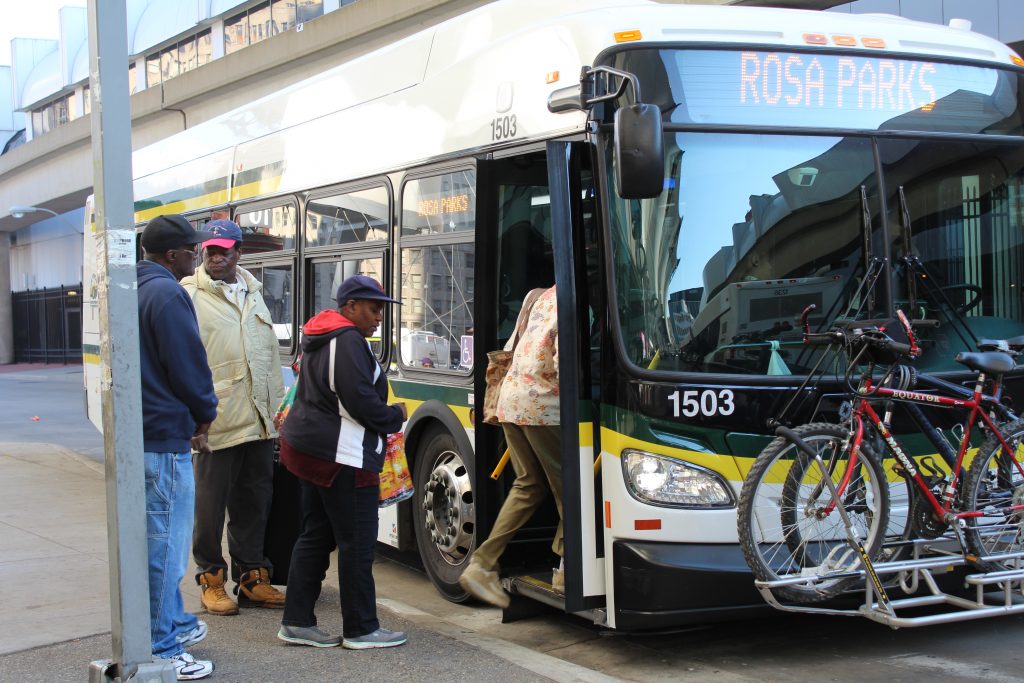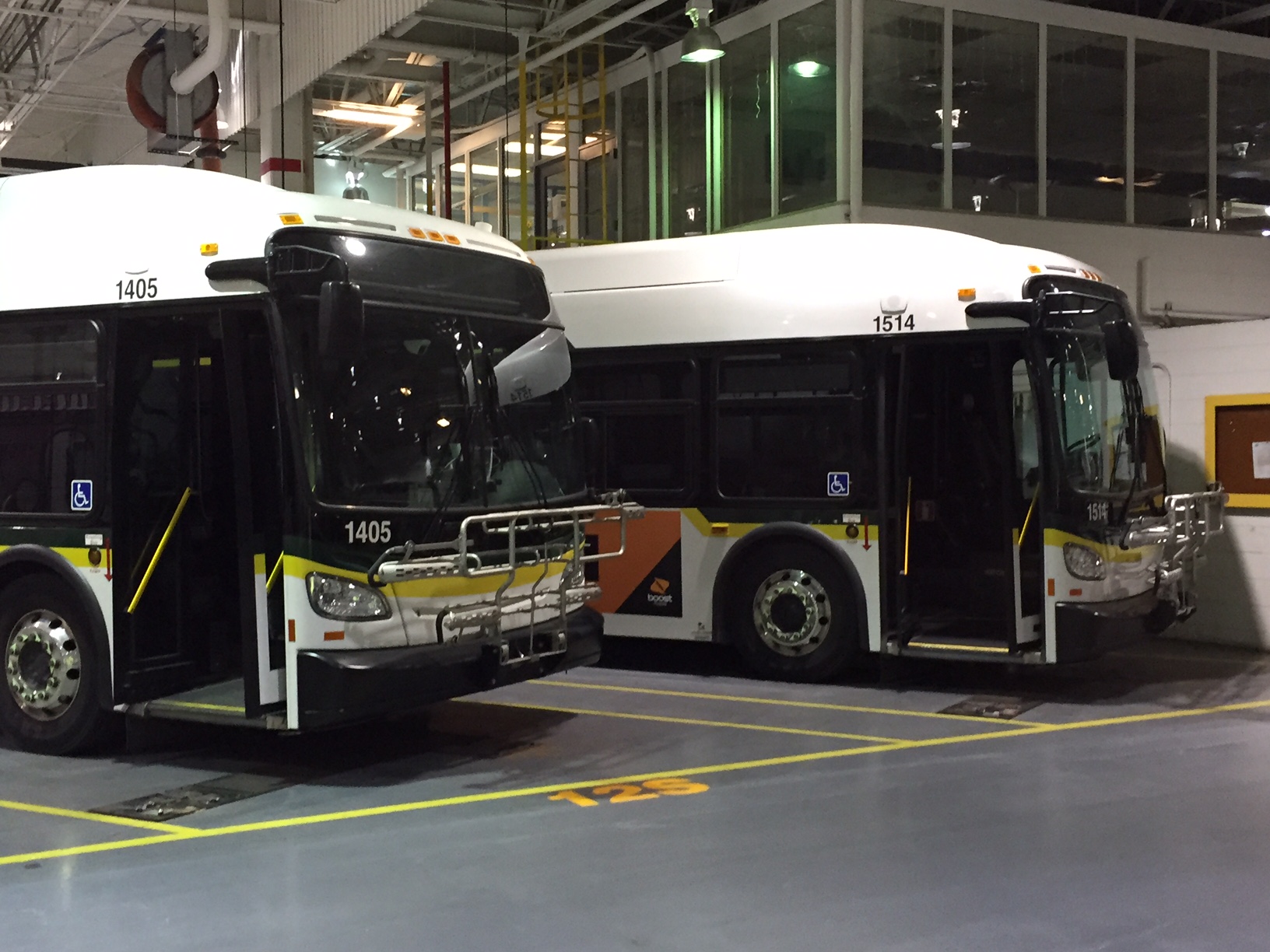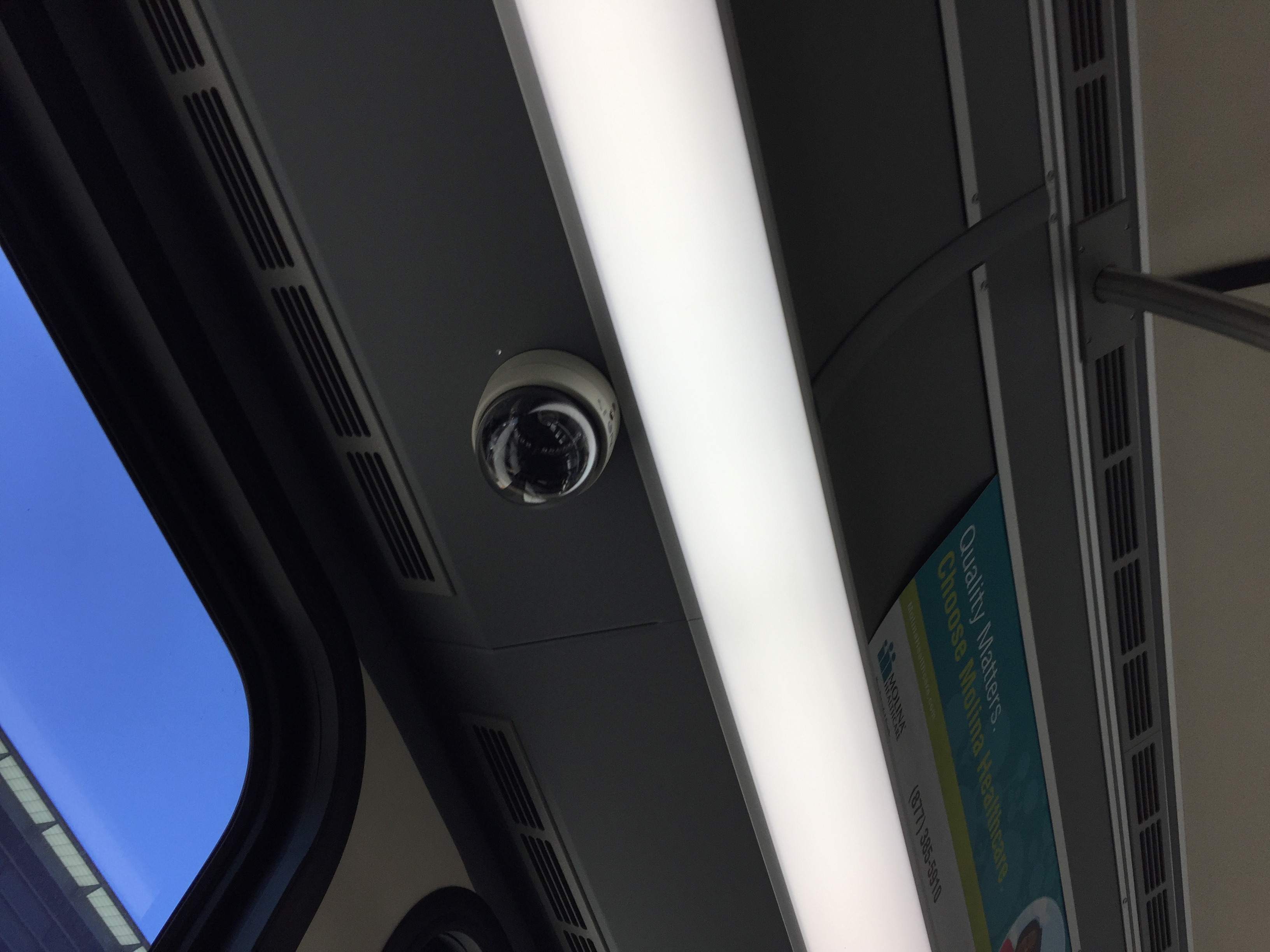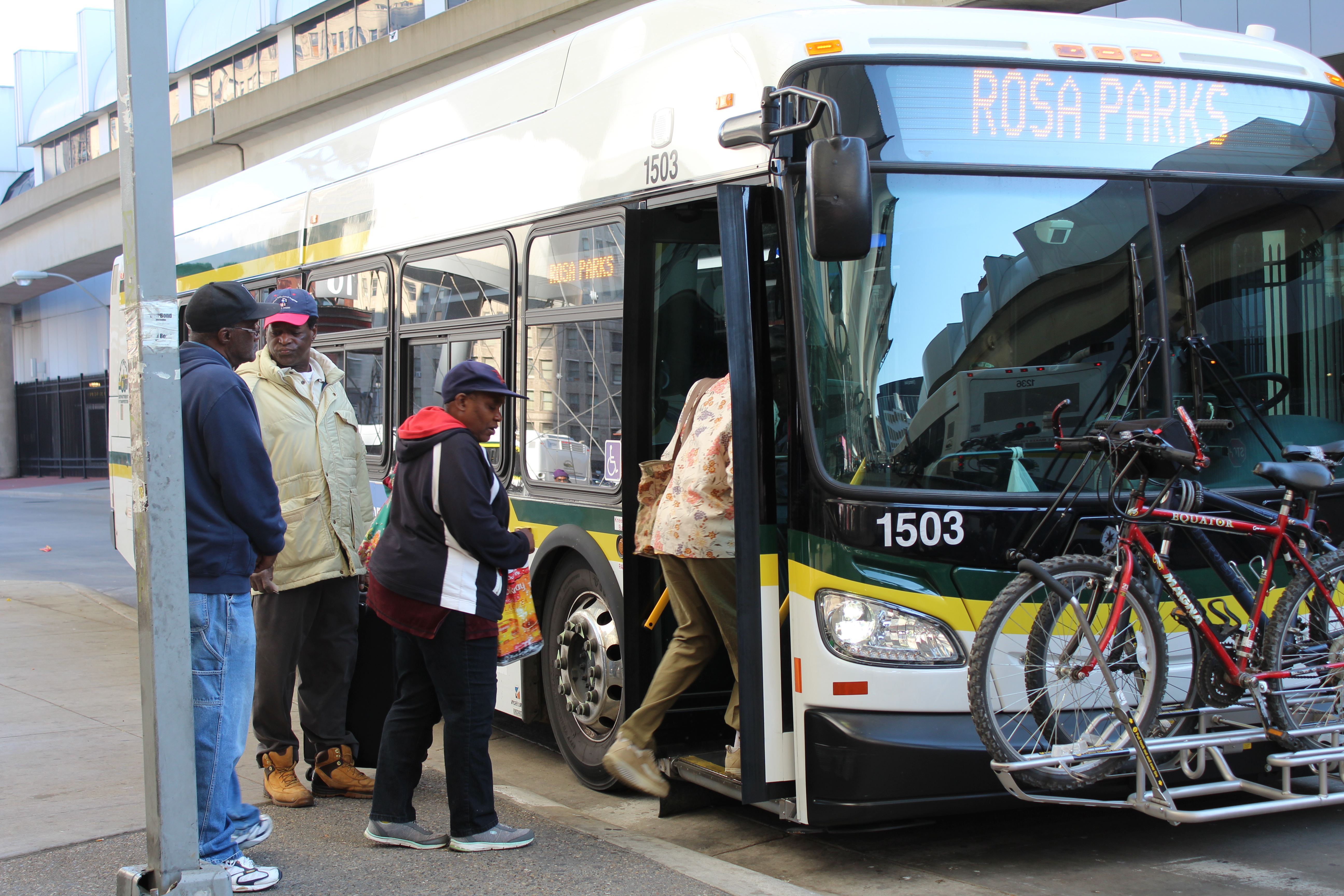A Detroit Transit Discussion: What is Working?
Since the end of Detroit’s bankruptcy, DDOT has bought new buses, made plans to expand service next year.

FILE - Riders board a DDOT bus in Detroit, Mich. in 2015.
As the one-year anniversary of Detroit’s emergence from bankruptcy approaches, WDET is examining how the city has changed. One thing city leaders are trying to change is the perception of its mass transit system. The city is getting $64 million from the State of Michigan to expand and improve Detroit bus service. The Legislature approved the funding and Governor Rick Snyder signed it into law Nov. 11. Mayor Mike Duggan says the money will allow the Detroit Department of Transportation (DDOT) to restore and expand service along many of the city’s key routes over the next six to seven years. He says the city’s bus system was an embarrassment when he took office.
“When I started here,” Duggan says, “there were days where 40 percent of the buses just didn’t show up. We didn’t have enough drivers, we couldn’t repair the buses, the buses were so old they weren’t salvageable. And you had people standing on the corner waiting an hour, hour-and-a-half for a bus. When they showed up, they generally took their frustrations out on the drivers, who were the ones who were showing up for work.”
Duggan says things are better now. But do riders share that view? And is there still room for improvement? As part of the Detroit Journalism Cooperative’s look at the city one year after bankruptcy, WDET’s Pat Batcheller moderated a panel discussion with DDOT Director Dan Dirks and Megan Owens of Transportation Riders United. Click on the audio player above to hear the conversation and read the transcript below:
More DDOT coverage from WDET:
DDOT Seeks Community Input (Nov. 10)
DDOT Budget Under Scrutiny (Mar. 16)
DDOT Bus Drivers Get Raises in New Contract (Oct. 5)
Pat Batcheller: We’ll start with you, Dan. The biggest change we’ve seen in the past year is the addition of some brand new buses. The federal government came through with money to help you update your fleet. How many buses have you been able to replace with new ones because of that?
Dan Dirks: We have been able to replace 80 new buses in the last year.

Batcheller: And how much money came from the government for that?
Dirks: Well, there was two sets of funds. One was existing formula dollars that come into DDOT and Smart and every transit system in the country, and that was about $15 million. And that was from a variety of different grants. The second source was a competitive grant called “Ladders of Opportunity”. And from that we were able, between state and federal funds, to get close to $30 million. And between the two, we were able to get the 80 new buses.
Batcheller: What happened to the old ones? Are any of them still on the road?
Dirks: No, the 80 that we replaced are in the process– if anyone’s been anywhere near Warren and I-75–we have a “back forty”. And those buses are in the process of being auctioned off. The city has an auction once a year, and those will be on the auction. Those buses have seen their better use.
Batcheller: It’s better to auction them off than to try to repair get them in working order?
Dirks: Yeah, I mean that’s been a big part of the issue of why we’ve tried to take them out of service. Because the amount of money you put in maintenance to keep them going is significant. And even with that, the breakdowns are still relatively high. As a comparison, we would have, even in terms of tows, probably 15 to 20 tows a week, and now we’re lucky if we get one or two. So you’re spending less money on maintenance. And it’s more on preventive maintenance than the repairs with the older buses.
Batcheller: Now, was this a onetime infusion of federal money, and if so, where would you get the money in the future to buy more new buses so that you can replace old ones?
Dirks: Approximately half of the money was formula dollars, so will be able to replace buses in the future as they become age-eligible. Half was competitive. And that’s the dollars that the mayor so aggressively went after with Vice President Biden and President Obama. And it’s a great story. I mean, when the mayor was first elected, he got a call from the White House and they asked what they could do to help the city out. And he said, “I need buses”. And so that’s the good news story. It took a little while to get them. But we were able to get them.
Batcheller: Now just out of curiosity, if you know, what is your largest source of revenue these days and what was it say ten years ago? How has the funding model for DDOT changed?
Dirks: Well, the largest source of operating dollars is basically the city subsidy. But that subsidy has gone down from $80 million ten years ago, or $100 million, down to about $35 million today. We get approximately 30% of our operating budget from the state, and that’s really gone down over the last ten years. And then fare box [revenues] account for about 10 to 15 percent of the operating cost.
Batch: Now as these buses hit the road, each of them contains security cameras which are intended to make buses safer. Have they?
Dirks: Oh, absolutely! If you look over the last year-and-a-half, the number of incidents on our buses have gone down dramatically. You know, it’s not to say every urban system has issues, but if somebody tries to do something on a bus, they’re going to be caught almost immediately between the cameras and the transit police that we have. We have 29 transit police budgeted for our service. We’re hiring a few of them, a few folks have quit in the last couple of months. So we’re going to get back up to 29. The transit police are riding the buses, and [with] the cameras, it’s worked out really well.

Batcheller: Megan Owens of Transportation Riders United, do you feel safer riding a bus these days? Is this something that people are still telling you is a concern, or have they seen improvement?
Owens: Most people who actually ride the bus recognize that it is a generally safe system. The reality is, you are in a big city and with almost 100-thousand people riding every day, yes, there are going to be some incidents that happen. But the perception is far worse than the reality. It’s people who don’t ride who think the buses are somehow horribly dangerous. Whereas most people who actually do ride realize that it’s a pretty safe way to go. There’s a group of people around you, there’s a driver that has a direct line to call in help as needed. And with these cameras, if something does happen, it doesn’t stop the problem immediately, but that person’s going to get caught very quickly.
Batcheller: Where does that perception come from?
Dirks: I think in the past where there were not cameras, and there weren’t any officers riding the buses, you could basically get away with it. But not anymore. In most cases, transit police are responding within minutes of any kind of incident that’s reported. A bus is a haven of safety for the most part.
Owens: I will say that there have been challenges in the past with overcrowded buses when there hadn’t been enough buses on the road. People still need to get where they need to go, so those people crammed onto the buses. And sometimes it’s hard for the driver. The driver’s first job is to drive safely, and secondarily, keeping an eye on what’s happening behind him. But when it got so overcrowded, that would both increase stress and tension and you would have some more incidents of push-and-shove and people getting upset. We’re starting to see a little bit less of that overcrowding as more buses are on the road. And, hopefully we’ll continue to see more service available to address those overcrowded routes. That also helps make it a little bit more of a comfortable trip and decrease some of the stress among passengers and drivers.
Batcheller: Is that what you’re hearing, Dan?
Dirks: Well, quite frankly, when the mayor first took office, we were supposed to get 189 buses out in the morning. We were getting about 140. Today, in the mornings, we’re getting 192 buses out, actually more than 189. And then in the afternoon, we’re supposed to get out 229, and we’re getting 229. So we are running all of the service that we should. We still have to work on on-time performance. And part of that relies on writing good schedules. We’ve hired a new scheduling manager in the last four months. And he doesn’t own a car–he’s got a bike, and he rides the bus. And between him and the staff, they’re riding a very high percentage of the trips. And we’re making sure the drivers have the right allotted amount of time. I mean, anyone that’s ridden the bus in Detroit knows there’s times when the driver leaves Rosa Parks Transit Center and goes like crazy. And then he gets to a certain point in the route, and he slows down very slow. And then he gets to a third point of the route and he goes like crazy again. And that’s because those schedules really need work. By January next year, they’re not going to be perfect because we can’t hit everything. But a significantly high percentage of those routes are going to be much better-timed. And the only way to do it is just ride the bus and get the input from the drivers. And that’s really the scheduling staff has been doing.
Batcheller: When I went to Rosa Parks Transit Center recently, I talked with some passengers. Obviously, not a scientific survey, but the most common complaint that I heard from passengers was that, in some cases, they’ve had confrontations with drivers. The phrase they used most often was a “bad attitude” on the part of drivers. Again, not a scientific survey, certainly not encompassing all drivers. But if there is a need to improve the relationship between drivers and passengers, how do both of you think that can be achieved?

Owens: Well, I do think that there’s a couple of pieces. One, by addressing some of these underlying problems that Dan has referenced. Getting enough buses actually operating. Adjusting the schedules so that they’re a little bit more realistic. You start to address some of the underlying tensions or stresses. If somebody has been waiting at a bus stop for 45 minutes, they’re late for work and they’re about to lose their job, the driver ends up being sort of the target of that anger, even though there may be nothing that driver can do about it. So, one step is certainly to address the things that Dan has already referenced, and bring down the overall stress level of everyone involved. I will say that the department’s also been working very hard at bringing on new drivers and training them very quickly to get them out on the road and operating those buses. And there may need to be some level of re-training or continuing education. An awful lot of jobs require some sort of continuing education and recognizing how to de-escalate a stressful situation. That certainly hasn’t been high on the priority list, but that might be another area that could help.
Dirks: Megan’s absolutely right. One of the first things you need to do is the re-training. And in the past, DDOT has not had enough drivers. We do now, and so re-training is going to be part of what we are all about. And the second thing is to call and complain. I mean, my phone number is (313) 833-7667. If you have a rude driver, give us the bus number, the time of day, and what route you’re running, and we’ll follow up. And we’ll bring that driver in. My experience–again, training is great, but some of the best things you can do is pull the individual driver in and find out what the real issue is. And oftentimes, there’s an underlying issue, as Megan was saying. It might be overcrowding. It might be an issue with a bus stop or whatever. So, you’re trying to not only correct the driver’s behavior, but find out what the root cause is.
Batcheller: And in defense of the drivers, they have to deal with hundreds of passengers every day on various routes. And maybe the passengers are rude. A lot of the safety issues that we’ve heard on buses isn’t just passengers. It’s for the benefit of the drivers. They need to be safe.
Owens: Absolutely. And that is definitely a big challenge. The drivers are being are put in a very difficult situation. I mean, they’re driving a giant vehicle on busy crowded roads. Anyone who’s driving on the streets knows that sometimes there are other jerks on the road. And then imagine having 20, 40, 60 different backseat drivers telling you how you should have been doing things differently. So, it’s a very difficult and stressful job for those drivers. As timeliness improves, as safety improves, as the drivers are able to get people where they need to go, hopefully the relationship between passengers and drivers can improve. Because ultimately, it’s a stressful situation on both ends. The vast majority of people who are riding are using it to get to work, to school, to job training, to get their kids at daycare. I mean I’ve got kids in day care. They start charging a dollar a minute when you’re late to pick up those kids at day care. Sometimes if they’re late more than two or three times, they’re going to lose their job. So the importance of that bus service to people’s lives is so critical. And I certainly applaud what Dan and his team have been doing to make it a more reliable system that people can really depend on.
Batcheller: And Mayor Duggan has made that point a number of times. He’s made it clear that Detroiters need a reliable bus service to get them to and from work, or school, or the doctor’s office. And he added that if there’s a perception out there that service may be lacking in some way, then it’s a challenge that DDOT obviously has to deal with. Is on-time service better these days, Dan, and what’s the average wait time for a bus now?
Dirks: Well, absolutely. We go on on-time performance. Buses being on time to five minutes late is considered “on time”. And about a year-and-a-half ago, we were in the 45-50% [range]. We’re now approaching 70% and above. And we have a number of lines that were in excess of the national standard of 80%. And we think by fine tuning the schedules, that’s going to really increase. One of the other things we’re looking at is actually getting rid of transfers and going to day passes. Because one of the biggest conflicts that driver has is over a transfer. If you’re transferring from one line to another, and the time stamp on it says you have until 1:00 and it’s 1:02, you don’t know what’s going to happen. Some drivers will give in, some won’t. A number of cities have actually eliminated transfers and gone to a day pass. You pay twice the regular fare and the transfer. In our case, it would be $3.50. And you can ride anywhere you want all day. And we think that will also decrease the amount of time it takes to get on the bus and make those buses on time. I mean that’s really what our goal is, so that a person knows they can go out and wait for the bus. And it’s going to be on time.
Batcheller: Is there anything we haven’t talked about that we should talk about?
Owens: I will say, and Dan certainly knows this, one of the things that my organization has called for is more transparency of information. Dan does have a lot of great data. And we applaud his team for really looking at that data and identifying ways that service can be improved. It is a public agency and that information should be publicly available. The city is putting some basic performance metrics up there so you can see those pull-outs, the number of buses that are pulling out each morning and each afternoon. And it’s been great to see those numbers increase or improve over the course of recent months. But having more timely access to public information for riders and for others would be a great additional step. That, and ultimately they are operating on a shoestring. Dan and his team are doing an incredible job trying to make the very best out of an extremely tight budget. They are operating on about half of what they had ten years ago. And they can only do so much. I mean, ultimately when you’ve got over 100-thousand people needing to get where they need to go, there will need to be additional funds provided into the system. Per the bankruptcy, at least the funds that DDOT is getting will be stable over the next few years. And that’s certainly something we are pleased to see after seeing it being gutted for so many years. But ultimately there needs to be additional funds for additional service to meet the needs of Detroiters. That’s honestly something that’s outside of Dan’s control, but will be critical to get the system where it needs to be.
Batcheller: Final thought, Dan?
Dirks: I appreciate that, Megan. I mean the thing is we need to be as efficient as possible and part of that, for example, is making better schedules. Part of that is treating our drivers with the respect they need to have. In many cases, they’re finishing their routes and they have very little time to use the restroom. We all have to treat them with respect. And in that regard, the state is considering a transportation package, of which transit would be funded. That would enable us over time to be able to do some of that expansion that Megan’s talked about, and what we would really like to do. But I think you’re going to see improvements as early as next January with what we’re hoping to do. Again, just by making that schedule as efficient as we possibly can.
Owens: If I can add, I do think, Dan, you bring up an excellent point. Both the Legislature here in Michigan and the U.S. Congress are debating transportation funding packages. Historically, a large portion of funding for bus systems all across our state has come from the state and federal governments. That has eroded for the past ten, 20, 30 years. And so if people are looking for a way that they can help, certainly contacting your state legislators and your federal legislators and making sure that funding for public transit is an integral part of both state and federal transportation packages. Just ten percent out of roads bills could go a long way toward ensuring that, not only DDOT, but SMART and other agencies all across the state have the funds they need to get people where they need to go reliably.


